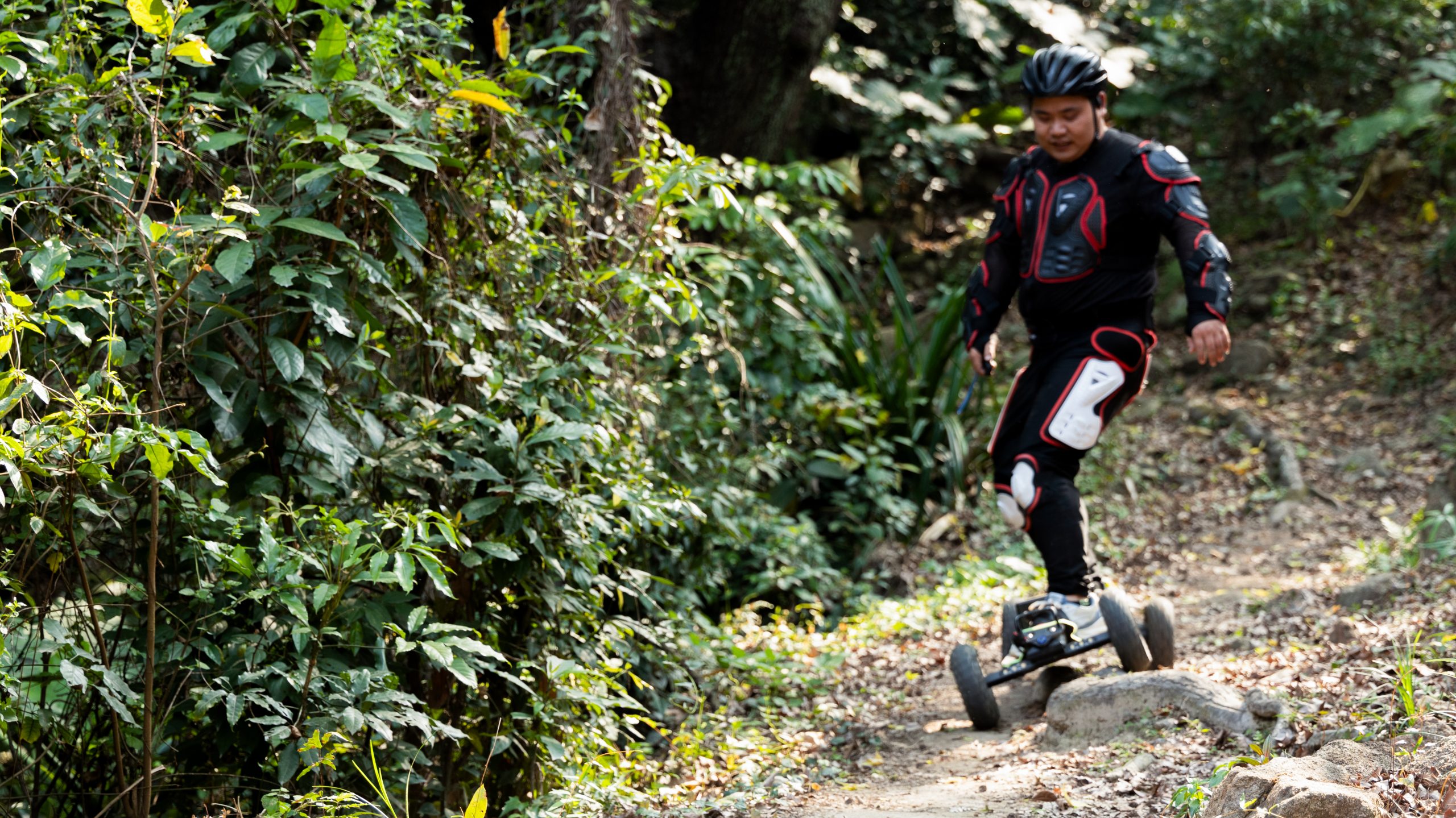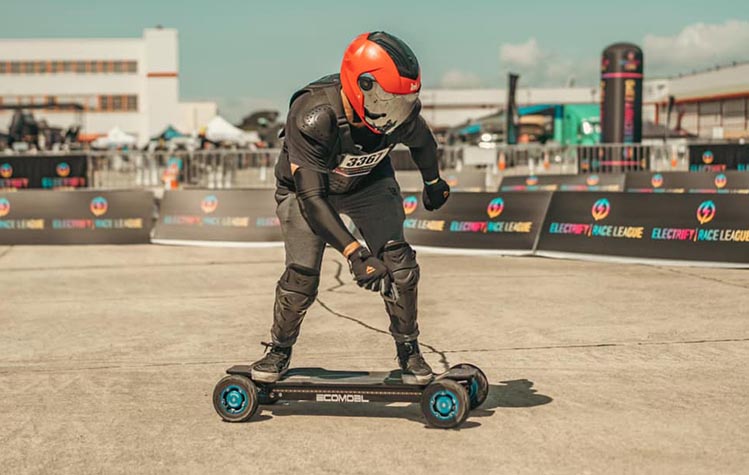Electric skateboarding is heart-pounding speed and unlimited freedom—but genuine mastery is realizing when and how to brake.
Whether carving down coast roads or cutting through city streets, braking is the unobtrusive art that converts adrenaline into mastery. Familiarity with your board’s braking system and technique development are not skills; they are your shield against the unknown.
In this guide, we unlock the professional braking techniques every e-boarder needs to ride harder, brake smarter, and push the boundaries of their electric skateboard adventures with complete confidence.
Understanding Your E-Skateboard’s Braking System
Mastering braking begins with understanding the technology behind it. To control your ride effectively, you must first know how your electric skateboard’s braking system actually works.
The braking mechanism of an electric skateboard largely relies on the reversing operation of the motor. When you press the brake button on the remote, it starts generating electricity and reversing the motion of the skateboard into energy that is channeled back to the battery. In the process, resistance is established, which brings the board to slow down.
Referred to as regenerative braking, the system not only helps you brake but also saves battery life. In more advanced boards, the system regulates the motor power during braking to be smoother and still operational even when the battery is almost full.
Four-wheel drive boards stop harder because all four wheels work to slow them down, while two-wheel drive boards rely on the rear wheels, so their braking distance is slightly longer.
Most electric skateboards also allow you to adjust the braking power according to different speeds and road surfaces. Again, remember that when nearly full-battery, braking capability can be affected, so it’s better to brake earlier when going downhill.

Proper Body Positioning for Optimal Braking
Stance Fundamentals for Effective Stops
The most advanced braking technology still requires proper rider technique to be effective. Proper emergency braking technique is essential for safety when you need to stop immediately. Stay centered over the board with knees bent for stability. Keep your head up and your body lowered. When initiating a brake on your board:
- Lower your center of gravity by bending your knees more than during regular riding
- Shift your weight slightly backward (avoiding excessive lean that causes loss of control)
- Engage your core muscles to maintain stability throughout the deceleration
- Keep shoulders aligned with the board to maintain directional control
Board-Specific Positioning:
- All-Terrain Models: Adopt a wider stance for maximum stability
- Urban Cruisers: Maintain a centered position for precision control
Progressive Braking Techniques for Smooth Stops
The Science of Smooth Deceleration
The hallmark of an experienced rider is the ability to execute smooth, progressive braking. When it comes to electric skateboard braking, control is everything. Abruptly slamming on the brakes can lead to unwanted consequences, such as skidding or losing control, especially at higher speeds.
Key Techniques:
- Gradual Force Application: Start with 20% braking power, then increase smoothly
Pulse Braking Method: Alternate between gentle braking and coasting for high-speed control- Momentum Management: Maintain forward stability by synchronizing body movement with deceleration
- Terrain Adaptation: Using your toes to ease off gradually and your heels for a more abrupt stop helps you manage things better, especially when dealing with various slopes.

Emergency Braking: When and How to Execute
Critical Response Protocol
While smooth deceleration is the goal during normal riding, unexpected situations demand rapid, precise emergency braking techniques.
Even with advanced planning, unexpected obstacles require emergency stopping power.
Pro techniques for you to
- Weight Distribution: Immediately shift backward while maintaining a low stance
- Controlled Force Application: Apply 70% braking power within the first second
- Core Engagement: Brace abdominal muscles to absorb deceleration forces
- Visual Focus: Keep eyes on your exit path, not the obstacle
Physics Reality Check:

At speeds of 25 mph (about 40 km/h), even the most powerful electric skateboard braking systems require real stopping distance. On dry, level ground, a typical high-performance e-board needs
around 15–16 meters (50–52 feet) to come to a complete stop, assuming proper technique and optimal brake settings.
On wet, loose, or downhill surfaces, this distance can easily extend to 20 meters (65 feet) or more.
There’s no realistic way to simply “run it out” at these speeds unless you have world-class sprinting ability. Braking effectively is not optional—it’s a critical survival skill. Always plan your braking window early and stay highly aware of your surroundings.
Braking on Different Road Conditions
Surface-Specific Braking Techniques
Your braking approach must adapt to changing terrain conditions for maximum safety and control.
| Surface Type | Technique Adjustment | ECOMOBL’s Offer |
| Smooth Pavement | Standard progressive braking | Predictable stopping distance |
| Wet Surfaces | Reduce force by 30%, extend stopping distance | Sealed electronics system |
| Downhill Terrain | Earlier initiation, gentle sustained pressure | Advanced ESC thermal management |
| Loose/Off-Road | Earlier braking with reduced initial force | All-terrain wheel grip optimization |
Rough or irregular terrain – bumps, debris, and cracks can all be serious obstacles. Every time you hit one of these, the path or direction of the board is affected. Our all-terrain models are specifically designed to handle these challenges while maintaining braking efficiency.
The Tech Behind ECOMOBL Braking Systems
- Regenerative Braking Technology: Converts kinetic energy back into battery power during stops
- Dynamic Electronic Braking: Adapts to riding conditions in real-time
- Motor Resistance Engineering: Creates smooth deceleration while preserving momentum
- Dual Braking Systems: Combines electronic and mechanical methods for reliable stopping power
Advanced braking algorithms in our high-performance models respond intelligently to your input. Regenerative braking helps skateboards recover energy when slowing. When the brakes are applied, the motor generates electrical energy for the batteries. Even at high speeds on our AT (all-terrain) models, this makes braking natural and predictable.
Common Braking Mistakes to Avoid
Critical Errors That Compromise Safety
Even experienced riders sometimes fall into these braking traps:
- Sudden Maximum Braking: Results in the board stopping faster than body momentum
- Rigid Body Position: Reduces ability to absorb deceleration forces
- Ignoring Terrain Changes: Leads to unexpected slides or ineffective stops
- Braking While Turning Sharply: Dramatically increases fall risk
Correction Strategy:
If you’re just getting into e-boarding, take serious time to practice in the beginning. Ride around in secure areas, like parking lots, and really get to know your board before moving to busier areas. Develop muscle memory through deliberate practice in controlled environments.
Maintenance Tips for Reliable Braking Performance
System Optimization Checklist
Your braking system requires regular maintenance to ensure peak performance:
- Remote Connectivity Verification:
- Test response time in safe environments
- Check for signal interference in high-EMF areas
- Verify battery level impact on braking signal
- Mechanical Systems Check:
- Check the tightness of your wheels, trucks, brakes, bearings, and tighten all screws of the electric skateboard, especially when riding on rough roads.
- Inspect motor connection integrity
- Check wheel bearings for smooth operation
- Software Maintenance:
- Keep firmware updated with latest releases
- Monitor braking performance after updates
- Back up custom settings before major updates
Upgrading Your Braking Experience
Performance Enhancement Options
For riders seeking next-level control precision, ECOMOBL offers strategic upgrade paths:
- Advanced ESC Technology:
- Granular braking curve customization
- Enhanced thermal management during extended braking
- Programmable braking response profiles
- Premium Remote Controls:
- Higher resolution input detection
- Adjustable brake sensitivity settings
- Haptic feedback during braking events
- Strategic Wheel Selection:
- Larger wheels → More stable, gradual braking
- Smaller wheels → More immediate stopping power
- Specialized compounds for wet-condition performance
Master Your Ride, Master Your Stops
Perfecting your braking technique isn’t just about safety—it’s about unlocking the true potential of your good electric skateboard. The confidence that comes from knowing you can stop precisely when and how you want allows you to push your limits and experience the full thrill of electric skateboarding.
Safety isn’t just an option; it’s an absolute necessity. With practice, maintenance, and the right equipment, you’ll develop a stopping finesse that matches the premium engineering of your ECOMOBL board.
Ready to elevate your electric skateboarding experience? Explore ECOMOBL‘s full range of high-performance e-skateboards and accessories.
Frequently Asked Questions
What should I do if my brakes fail?
Stay calm and: 1) Try turning uphill to naturally reduce speed, 2) Perform a controlled foot drag with your back foot, or 3) Execute a controlled bail-out if necessary. Practice these emergency techniques in safe environments before you need them. Have your board inspected after any brake failure.
How often should I check my braking system?
Perform a quick functionality test before every ride and thorough weekly inspections of remote connectivity, response time, and components. Check more frequently after riding in wet conditions or on rough terrain. Address unusual sounds, delayed response, or inconsistent braking immediately.
How reliable are electric skateboard brakes?
ECOMOBL brakes are highly reliable thanks to dual braking systems (electronic and regenerative). Reliability depends on battery level, maintenance, and board quality. No system is 100% fail-proof, so we recommend learning foot braking as a backup and performing regular checks on your system.
Can I brake safely when going downhill?
Yes, but use specific techniques: start braking earlier, apply gentle sustained pressure (not sudden stops), shift weight slightly to your back foot, and use intermittent “pulse braking” on longer descents to prevent overheating. ECOMOBL’s thermal management systems are designed specifically for downhill braking challenges.




